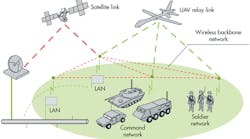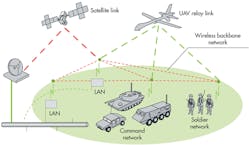This file type includes high resolution graphics and schematics when applicable.
As the demand rises for sophisticated tactical wireless communication networks to aid in modern warfare, security, and disaster relief, wireless-network designers must find creative solutions to handle the immense amount of wireless traffic arising in tactical situations. A wireless network with the ability to assess its environment and make resource-allocation decisions based upon the conditions in the field could be the next step in advancing tactical wireless communications. Getting the most out of crowded wireless resources is a forte of cognitive-radio (CR) technology and the topic of the white paper by Elektrobit (EB) titled ”Cognitive Tactical Communication Networks.”
The official definition of CR by the International Telecommunications Union (ITU) is as follows: “A radio system employing technology that allows the system to obtain knowledge of its operational and geographical environment, established policies and its internal state; to dynamically and autonomously adjust its operational parameters and protocols according to its obtained knowledge in order to achieve predefined objectives; and to learn from the results obtained.” This directive is the backbone of what EB is currently developing: technology to deploy CR radios in practical situations. An example of EB’s research and development is the EB Tactical Wireless IP Network (TAC WIN), a mobile ad-hoc network (MANET) with wireless-broadband connectivity designed for deployment in any location.
The goal of this development is to produce a CR with spectrum awareness, collaborative sensing, fast response time, awareness/collaboration with other network resources, algorithms for resource management, and an artificial-intelligence-based cognitive engine. Compared to civilian cognitive networks, which use present resources to enhance system capacity, a tactical cognitive radio would need to incorporate more flexible systems of resource utilization. This approach includes wireless links from satellites, UAVs, and wired connections that can use a variety of stealth and anti-interference methods to compensate for hostile environments (see figure).
This enhanced communications method would require detailed data from a variety of sensors across several wireless networks. The data would then be processed centrally and routed intelligently using adaptive antennas with specific localization within a MANET. The TAC WIN system is designed around a modular software core that can support future upgrades. Such improvements could include advanced data capacity, smarter resource allocation, new waveforms, increased cognitive functionality, and increased throughput.
Elektrobit, 22745 29th Dr. SE, Ste. 200, Bothell, WA 98021; (425) 686-3100.
This file type includes high resolution graphics and schematics when applicable.


